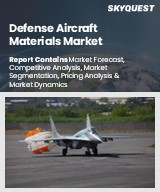
세계의 방위 항공기 재료 시장 규모는 2023년에 18억 달러로 평가되며, 2024년 18억 8,000만 달러에서 2032년에는 27억 달러로 성장하며, 예측 기간(2025-2032년)의 CAGR은 4.6%로 성장할 전망입니다.
세계 방산 항공기 소재 시장은 지정학적 긴장 고조, 현대화 노력, 전쟁 기술의 발전으로 인해 크게 성장하고 있습니다. 각국은 스텔스성, 속도, 내구성을 우선시하는 첨단 항공 함대 개발에 점점 더 많은 노력을 기울이고 있으며, 제조업체들은 탄소 복합재, 티타늄 합금, 레이더 흡수 구조와 같은 우수한 소재를 모색하고 있습니다. 이러한 소재는 연료 효율을 높일 뿐만 아니라 구조적 무결성과 기동성을 향상시켜 차세대 전투기에 필수적인 요소로 자리 잡고 있습니다. 또한 방위 기관의 엄격한 안전 및 성능 규제로 인해 주문자상표부착생산(OEM) 업체들은 고성능, 경량화, 지속가능한 소재에 투자하고 있습니다. 이러한 규제 환경은 각 지역의 국방 예산 증가와 함께 계약업체들에게 기술 혁신을 요구하고 있으며, 그 결과 재료공학이 항공 전략의 핵심으로 자리 잡게 되었습니다.
Global Defense Aircraft Materials Market size was valued at USD 1.8 billion in 2023 and is poised to grow from USD 1.88 billion in 2024 to USD 2.7 billion by 2032, growing at a CAGR of 4.6% during the forecast period (2025-2032).
The global defense aircraft materials market is experiencing significant growth driven by heightened geopolitical tensions, modernization efforts, and advancements in warfare technology. Nations are increasingly focusing on developing advanced air fleets that prioritize stealth, speed, and durability, leading manufacturers to explore superior materials such as carbon composites, titanium alloys, and radar-absorbing structures. These materials not only enhance fuel efficiency but also improve structural integrity and maneuverability, making them vital for next-generation fighter aircraft. Additionally, the imposition of stringent safety and performance regulations by defense agencies pushes original equipment manufacturers (OEMs) to invest in high-performance, lightweight, and sustainable materials. This regulatory landscape, coupled with rising defense budgets across regions, compels contractors to innovate, thereby placing material engineering at the core of their aviation strategy.
Top-down and bottom-up approaches were used to estimate and validate the size of the Global Defense Aircraft Materials market and to estimate the size of various other dependent submarkets. The research methodology used to estimate the market size includes the following details: The key players in the market were identified through secondary research, and their market shares in the respective regions were determined through primary and secondary research. This entire procedure includes the study of the annual and financial reports of the top market players and extensive interviews for key insights from industry leaders such as CEOs, VPs, directors, and marketing executives. All percentage shares split, and breakdowns were determined using secondary sources and verified through Primary sources. All possible parameters that affect the markets covered in this research study have been accounted for, viewed in extensive detail, verified through primary research, and analyzed to get the final quantitative and qualitative data.
Global Defense Aircraft Materials Market Segments Analysis
Global Defense Aircraft Materials Market is segmented by Material, Product, Application and region. Based on Material, the market is segmented into Aluminum Alloys, Steel Alloys, Titanium Alloys and Composite Material. Based on Product, the market is segmented into Cleaning Chemicals, Aviation Paint Strippers, Degreasers, Aircraft Leather Cleaners, Specialty Solvents, Aircraft Wash and Polishes and Others. Based on Application, the market is segmented into Transport Aircraft, Combat Aircrafts, Military Cargo, Helicopters and Others. Based on region, the market is segmented into North America, Europe, Asia Pacific, Latin America and Middle East & Africa.
Driver of the Global Defense Aircraft Materials Market
The Global Defense Aircraft Materials market is experiencing heightened demand for lightweight and durable materials due to a growing focus on enhancing fuel efficiency, maneuverability, and payload capacity. The incorporation of advanced composites, high-strength alloys, and nanomaterials plays a crucial role in minimizing weight while maintaining structural integrity. This shift in materials leads to significant improvements in range, speed, and overall operational performance, benefiting not only new aircraft fleets but also upgrades across all branches of the military. As defense organizations prioritize these technological advancements, the market is poised for substantial growth, driven by innovations in material science and engineering.
Restraints in the Global Defense Aircraft Materials Market
The Global Defense Aircraft Materials market faces significant restraints due to the elevated costs associated with advanced defense-grade materials, such as titanium alloys and carbon fiber-reinforced composites. The intricate manufacturing processes and rigorous performance requirements contribute to these high expenses, presenting budgetary challenges, especially within developing economies. As a result, the financial constraints may hinder the timely integration of cutting-edge materials into defense initiatives that prioritize cost efficiency. Consequently, the need for economically viable solutions and accessible materials remains critical for fostering innovation and ensuring the advancement of defense aircraft technologies in a competitive market.
Market Trends of the Global Defense Aircraft Materials Market
The Global Defense Aircraft Materials market is witnessing a significant trend towards the increased integration of AI and digital twin technology in material design. This shift enables more sophisticated modeling of material behavior, enhancing the accuracy of material selection and expediting the development process to meet stringent defense regulations. Moreover, such innovations facilitate real-time evaluations of critical parameters like durability, weight efficiency, and environmental resistance. As a result, defense manufacturers are better positioned to optimize aircraft performance, reduce development timelines, and promote sustainability, driving growth and competitiveness in the defense sector as technological advancements redefine material engineering strategies.